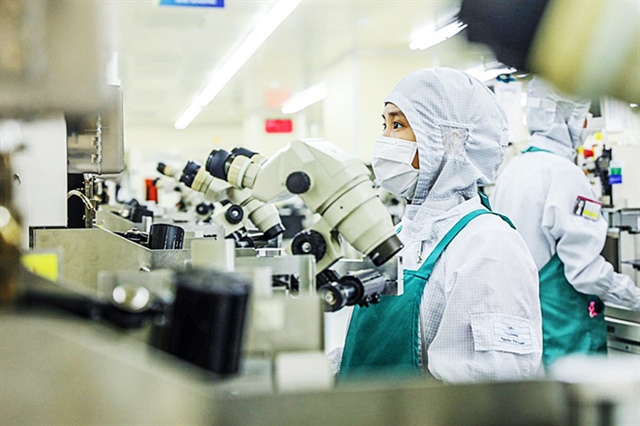|
Vietnam to invest $1bn in training 50,000 semiconductor engineers
Vietnam aims to invest approximately US$1 billion in training 50,000 semiconductor engineers by 2030, a strategic initiative projected by the Ministry of Planning and Investment to potentially yield indirect revenues of around $15-16 billion for the economy.

A semiconductor engineer training class of the Vietnam National Innovation Center in Hanoi. Photo: B.Ngoc / Tuoi Tre
|
Vo Xuan Hoai, deputy director of the Vietnam National Innovation Center (NIC), affirmed with Tuoi Tre (Youth) newspaper that training establishments, universities, and institutes nationwide were capable of training the 50,000 semiconductor engineers.
As directed by the Ministry of Planning and Investment, NIC has coordinated with relevant agencies to build a plan to develop the semiconductor sector until 2030 with a vision to 2045 and connect with domestic and foreign partners to support universities and training centers in Vietnam to develop the manpower for the sector, Hoai informed.
During Vietnamese Prime Minister Pham Minh Chinh’s working trip to the U.S., NIC inked cooperation agreements with Synosys and Cadence, the world’s largest suppliers of chip design software.
Through the deal, NIC can provide copyrighted software to local universities, the NIC deputy director noted.
NIC has also cooperated with the U.S.’s Arizona State University, which is the largest semiconductor engineer training establishment in the world, to develop training programs and take advantage of resources supported by the U.S..
NIC has worked with Google to provide some 30,000 scholarships to university students nationwide per year. The number of scholarships will increase to 40,000 this year.
The center has also joined hands with the U.S. Agency for International Development to train human resources for innovation and start-up ecosystems.
NIC has also cooperated with Cadence and Vietnamese tech giant FPT to launch training courses for students and offer scholarships to outstanding chip designing students.
It has also joined forces with the Vietnam National University-Ho Chi Minh City and the Vietnam National University-Hanoi to organize training programs for lecturers, using software of Cadence.
Universities and training establishments in Vietnam are capable of providing 50,000 high-skilled engineers until 2030, Hoai affirmed, citing a survey by the Ministry of Planning and Investment.
With good short-term training programs, they can train more engineers with higher quality.
In the coming time, Vietnam will continue attracting FDI enterprises to get involved in packaging, testing, producing, and designing phases.
By 2030, Vietnam needs an estimated 35,000 engineers for these phases and 13,500 chip designers.
Vietnam can also send engineers to South Korea, Taiwan, Japan, and the U.S. for work.
 |
| Employees are at work at a factory of Hana Micron Vina Co. Ltd. in Bac Giang Province, northern Vietnam. Photo: Ha Quan / Tuoi Tre |
Regarding difficulties for the semiconductor engineer training, Hoai said training programs face obstacles in policies. Vietnam has yet to complete semiconductor industry development strategies and draw up plans for the future.
The training of manpower for the semiconductor sector requires huge investment and incentives, which should be included in the lawmaking National Assembly’s law documents and resolutions.
Vietnam should also issue policies to lure Vietnamese-born talents and international experts to join the training process as the process must meet international standards, the NIC deputy director added.
As for infrastructure, the Hanoi University of Science and Technology, the Vietnam National University-Ho Chi Minh City, and the Vietnam National University-Hanoi have set up research centers and labs for the semiconductor sector. However, these facilities have a small scale and focus on design and studying materials only.
NIC plans to source the state budget, localities’ budgets, and private resources to invest in small and medium training centers at universities and research-training centers in Hanoi City, Da Nang City in the central region, and Ho Chi Minh City.
Mai Anh Tuan, a lecturer at the Vietnam National University-Hanoi, who directly trains semiconductor engineers at NIC, said the center was organizing three short-term courses in Hanoi, Da Nang, and Ho Chi Minh City for 76 trainees, who are excellent final-year students of leading technology universities in Vietnam.
The students are trained in an international environment and expected to immediately work after the courses.
Trainers are those with at least 30 years of experience in semiconductor each.
Lecturers in Texas are responsible for theory lessons, while Vietnamese ones are in charge of instructing the students’ practice.
Tuoi Tre News
|